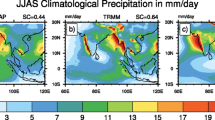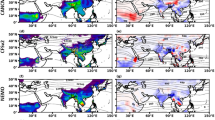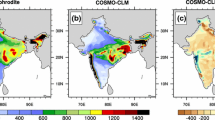Abstract
This study investigates predictability of the sub-seasonal Indian summer monsoon (ISM) circulation and its relation with rainfall variations in the coupled model National Centers for Environmental Prediction (NCEP) Climate Forecast System version 2 (CFSv2). Hindcasts based on CFSv2 for the period of 1982–2009 are used for detailed analysis. Though the model is capable of predicting the seasonal ISM rainfall at long lead months, the predication skill of the model for sub-seasonal rainfall in general is poor for short and long lead except for September. Rainfall over the ISM region/Indian Subcontinent is highly correlated with the low-level jet (LLJ) or Somali jet both in the observations and the model. The model displays improved skill in predicting LLJ as compared to precipitation in seasonal mean and September, whereas the model skill is poor for June and August. Detailed analysis reveals that the model LLJ variations throughout the season are overdependent on the El Niño-Southern Oscillation (ENSO) unlike in the observations. This is mainly responsible for the model’s low skill in predicting LLJ especially in July and August, which is the primary cause for the poor rainfall skill. Though LLJ is weak in September, the model skill is reasonably good because of its ENSO dependency both in model and the observations and which is contributed to the seasonal mean skill. Thus, to improve the skill of seasonal mean monsoon forecast, it is essential to improve the skill of individual months/sub-seasonal circulation and rainfall skill.









Similar content being viewed by others
References
Ashok, K., Guan, Z., & Yamagata, T. (2001). Impact of the Indian Ocean dipole on the relationship between the Indian monsoon rainfall and ENSO. Geophysical Research Letters, 28(23), 4499–4502.
Bandgar, A. B., Chowdary, J. S., & Gnanaseelan, C. (2014). Indian summer monsoon rainfall predictability and variability associated with Northwest Pacific circulation in a suit of coupled model hindcasts. Theoretical and Applied Climatology, 118, 69–79. doi:10.1007/s00704-013-1051-5.
Bhanukumar, O. S. R. U., Rao, S. R., & Raju, S. S. (2010). Study of interannual and intra-seasonal variability of summer monsoon circulation over India. Canadian Journal of Pure and Applied Sciences, 4(2), 1199–1206.
Boos, W. R., & Emanuel, K. A. (2009). Annual intensification of the Somali jet in a quasi-equilibrium framework: Observational composites. Quaternary Journal of Royal Meteorological Society, 135, 319–335.
Boschat, G., Terray, P., & Masson, S. (2011). Robustness of SST teleconnections and precursory pattern associated with the Indian summer monsoon. Climate Dynamics, 38, 2143–2165. doi:10.1007/s00382-011-1100-7.
Chaudhari, H. S., Pokhrel, S., Rahman, H., Dhakate, A., Saha, S. K., Pentakota, S., et al. (2015). Influence of Upper Ocean on Indian summer monsoon rainfall: Studies by observation and NCEP Climate Forecast System (CFSv2). Theoretical and Applied Climatology, 125, 413–426. doi:10.1007/s00704-015-1521-z.
Cherchi, A., Gualdi, S., Behera, S., Luo, J. J., Masson, S., Yamagata, T., et al. (2007). The influence of tropical Indian Ocean SST on the Indian summer monsoon. Journal of Climate, 20, 3083–3105.
Chowdary, J. S., Chaudhari, H. S., Gnanaseelan, C., Parekh, A., Rao, A. S., Sreenivas, P., et al. (2014a). Summer monsoon circulation and precipitation over the tropical Indian Ocean during ENSO in the NCEP climate forecast system. Climate Dynamics, 42, 1925–1947. doi:10.1007/s00382-013-1826-5.
Chowdary, J. S., Gnanaseelan, C., Sinha, S. K., & Thompson, B. (2006). A study of the variability of atmospheric and oceanic processes over the Arabian Sea during contrasting monsoons. Meteorology and Atmospheric Physics, 94, 65–85.
Chowdary, J. S., Raju, A., Lee, J. Y., Kosaka, Y., et al. (2014b). Seasonal prediction of distinct climate anomalies in the summer 2010 over the tropical Indian Ocean and South Asia. Japan Meteorological Society, 92, 1–16.
Dee, D., et al. (2011). The ERA-interim reanalysis: Configuration and performance of the data assimilation system. Quaternary Journal of Royal Meteorological Society, 137, 553–597.
Findlater, J. (1969a). A major low-level air current near the Indian Ocean during northern summer. Quaternary Journal of Royal Meteorological Society, 95, 362–380.
Findlater, J. (1969b). Inter-hemispheric transport of air in the lower troposphere over the western Indian Ocean. Quaternary Journal of Royal Meteorological Society, 95, 400–403.
Goswami, B. N. (1998). Interannual variations of Indian summer monsoon in a GCM: External conditions versus internal feedbacks. Journal of Climate, 11, 501–522.
Goswami, B. N., Krishnamurthy, V., & Annamalai, H. (1999). A broad scale circulation index for the interannual variability of the Indian summer monsoon. Quaternary Journal of Royal Meteorological Society, 125, 611–633.
Griffies, S., Harrison, M. J., Pacanowski, R. C., Anthony, R. (2004). A Technical Guide to MOM4, GFDL Ocean Group, Technical Report No. 5, NOAA/Geophysical Fluid Dynamics Laboratory, Princeton, NJ, p. 342.
Hoskins, B. J., & Rodwell, M. J. (1995). A model of the Asian summer monsoon. Part I: The global scale. Journal of Atmospheric Sciences, 52, 1329–1340.
Joseph, P. V., Gokulpalan, B., Nair, A., & Wilson, S. S. (2013). Variability of summer monsoon rainfall in India on inter-annual and decadal time scales. Atmospheric and Oceanic Science Letters, 6, 398–403.
Joseph, P. V., & Raman, P. L. (1966). Existence of low level westerly jet stream over peninsular India during July. Indian Journal of Meteorology Geophysics, 17, 407–410.
Joseph, P. V., & Sijikumar, S. (2004). Intraseasonal variability of the low level jet stream of the Asian summer monsoon. Journal of Climate, 17, 1449–1458.
Joseph, P. V., Sooraj, K. P., & Rajan, C. K. (2006). The summer monsoon onset process over south Asia and an objective method for the date of monsoon onset over Kerala. International Journal of Climatology, 26, 1871–1893. doi:10.1002/joc.1340.
Kim, H. M., Webster, P. J., Curry, J. A., & Toma, T. E. (2012). Asian summer monsoon prediction in ECMWF System 4 and NCEP CFSv2 retrospective seasonal forecasts. Climate Dynamics, 39, 2975–2991. doi:10.1007/s00382-012-1470-5.
Kripalani, R. H., & Kulkarni, A. (1999). Climatological impact of El Niño/La Niña on the Indian monsoon: A new perspective. Weather, 52, 39–46.
Krishnamurthy, V., & Kinter, J. L. (2003). The Indian monsoon and its relation to global climate variability. In X. Rodó & F. A. Comín (Eds.), Global Clim (pp. 186–236). Springer, Berlin.
Krishnamurti, T. N., Ardanuy, P., Ramanathan, Y., & Pasch, R. (1981). On the onset vortex of the summer monsoon. Monthly Weather Review, 109, 344–363.
Krishnamurti, T. N., Molinari, J., & Pan, H. L. (1976). Numerical simulation of the Somali jet. Journal of Atmospheric Sciences, 33, 2350–2362.
Lin, M., Fan, K., & Wang, H. (2008). Somali jet changes under the global warming. Acta Meteorologica Sinica, 22, 502–510.
Mitra, A. K., Stefanova, L., Vijayakumar, T. S. V., & Krishnamurti, T. N. (2005). Seasonal prediction for the Indian monsoon region with FSU ocean-atmosphere coupled model: Model mean and 2002 anomalous drought. Pure and Applied Geophysics, 162, 1431–1454.
Parthasarathy, B., Rupakumar, K. R., & Kothawale, D. R. (1992). Indian summer monsoon rainfall indices: 1871–1990. Meteorological Magazine, 121, 174–186.
Rajeevan, M., Gadgil, S., & Bhate, J. (2010). Active and break spells of Indian summer monsoon. Journal of Earth System Science, 119(3), 229–247.
Raju, A., Parekh, A., Chowdary, J. S., & Gnanaseelan, C. (2014). Impact of satellite retrieved atmospheric temperature profiles assimilation on Asian summer monsoon simulation. Theoretical and Applied Climatology, 116, 317–326.
Raju, A., Parekh, A., Chowdary, J. S., & Gnanaseelan, C. (2017). Reanalysis of the Indian summer monsoon: Four dimensional data assimilation of AIRS retrievals in a regional data assimilation and modeling framework. Climate Dynamics. doi:10.1007/s00382-017-3781-z.
Raju, A., Parekh, A., Sreenivas, P., Chowdary, J. S., & Gnanaseelan, C. (2015). Estimation of improvement in Indian summer monsoon circulation by assimilation of satellite retrieved temperature profiles in WRF model. IEEE Journal of Selected Topics in Applied Earth Observations and Remote Sensing, 8(4), 1591–1600.
Ramu, D. A., Sabeerali, C. T., Chattopadhyay, R., Rao, D. N., George, G., Dhakate, A. R., et al. (2016). Indian summer monsoon rainfall simulation and prediction skill in the CFSv2 coupled model: Impact of atmospheric horizontal resolution. Journal of Geophysical Research: Atmospheres, 121, 2205–2221. doi:10.1002/2015JD024629.
Reynolds, R. W., Rayner, N. A., Smith, T. M., Stokes, D. C., & Wang, W. (2002). An improved in situ and satellite SST analysis for climate. Journal of Climate, 15, 1609–1625.
Saha, S. K., Pokhrel, S., Salunke, K., Dhakate, A., Chaudhari, H. S., Rahaman, H., et al. (2016). Potential predictability of Indian summer monsoon rainfall in NCEP CFSv2. Journal of Advances in Modeling Earth System, 8, 96–120. doi:10.1002/2015MS000542.
Saha, S., et al. (2014). The NCEP climate forecast system version 2. Journal of Climate, 27, 2185–2208. doi:10.1175/JCLI-D-12-00823.1.
Saji, N. H., Goswami, B. N., Vinayachandran, P. N., & Yamagata, T. (1999). A dipole mode in the tropical Indian Ocean. Nature, 401(6751), 360–363.
Sayantani, O., Gnanaseelan, C., Chowdary, J. S., Parekh, A., & Rahul, S. (2015). Arabian Sea SST evolution during spring to summer transition period and the associated processes in coupled climate models. International Journal of Climatology, 36, 2541–2554.
Sperber, K. R., Palmer, T. N. (1994). Atmospheric model intercomparison project: Monsoon simulations. In Proceedings of International Conference on Monsoon Variability and Prediction. Trieste, May 9–13, WMO/TD-619, pp. 601–660.
Terray, P., Guilyardi, E., Fischer, A. S., & Delecluse, P. (2005). Dynamics of the Indian monsoon and ENSO relationships in the SINTEX global coupled model. Climate Dynamics, 24, 145–168.
Walker, J. M., Bordoni, S., & Schneider, T. (2015). Interannual variability in the large-scale dynamics of the South Asian Summer Monsoon. Journal of Climate, 28, 3731–3750.
Wang, B., Ding, Q., & Joseph, P. V. (2009). Objective definition of the Indian summer monsoon onset. Journal of Climate, 22(12), 3303–3316.
Wang, B., Wu, R., & Lau, K. M. (2001). Interannual variability of the Asian summer monsoon: Contrasts between the Indian and the Western North Pacific–East Asian monsoons. Journal of Climate, 14, 4073–4090.
Webster, P. J., Magana, V. O., Palmer, T. N., Shukla, J., Tomas, R. A., Yanai, M., et al. (1998). Monsoons: Processes, predictability, and the prospects for prediction. Journal of Geophysical Research-Oceans, 103, 14451–14510.
Xie, P., & Arkin, P. A. (1997). Global precipitation: A 17-year monthly analysis based on gauge observations, satellite estimates, and numerical model outputs. Bulletin of American Meteorological Society, 78, 2539–2558.
Acknowledgements
We thank the Director of ESSO-IITM and the Ministry of Earth Sciences, Government of India for support. We sincerely thank the Editor and the anonymous reviewer for their valuable comments that helped us to improve the manuscript. Figures are prepared in GrADS. We thank NCEP for providing CFS hindcast data, which are freely available (online available at http://cfs.ncep.noaa.gov). NOAA_OI_SST_V2 data provided by the NOAA/OAR/ESRL PSD, Boulder, Colorado, USA, from their web site at http://www.esrl.noaa.gov/psd/.
Author information
Authors and Affiliations
Corresponding author
Rights and permissions
About this article
Cite this article
Sagalgile, A.P., Chowdary, J.S., Srinivas, G. et al. Indian Summer Monsoon Sub-seasonal Low-Level Circulation Predictability and its Association with Rainfall in a Coupled Model. Pure Appl. Geophys. 175, 449–463 (2018). https://doi.org/10.1007/s00024-017-1702-z
Received:
Revised:
Accepted:
Published:
Issue Date:
DOI: https://doi.org/10.1007/s00024-017-1702-z




